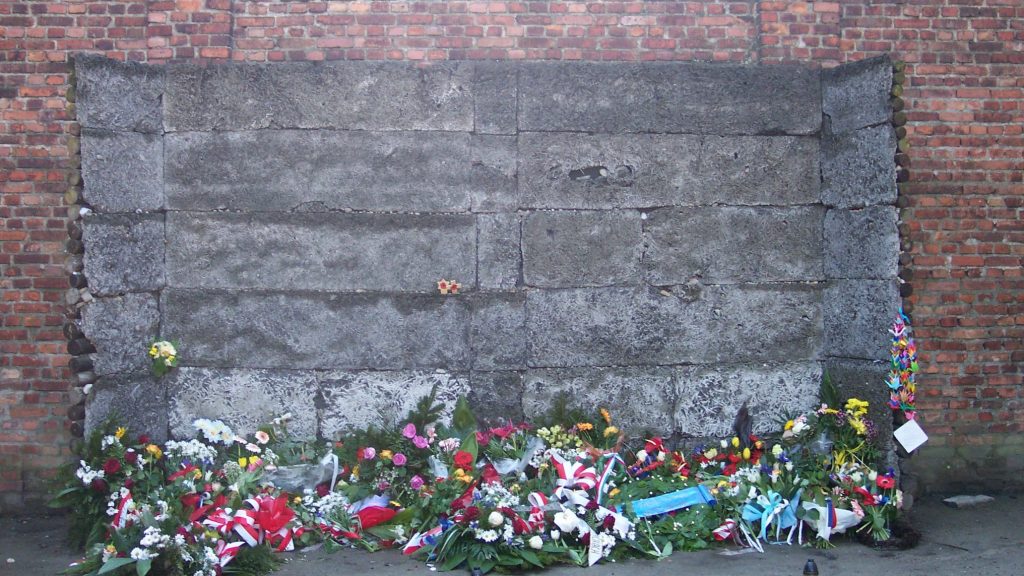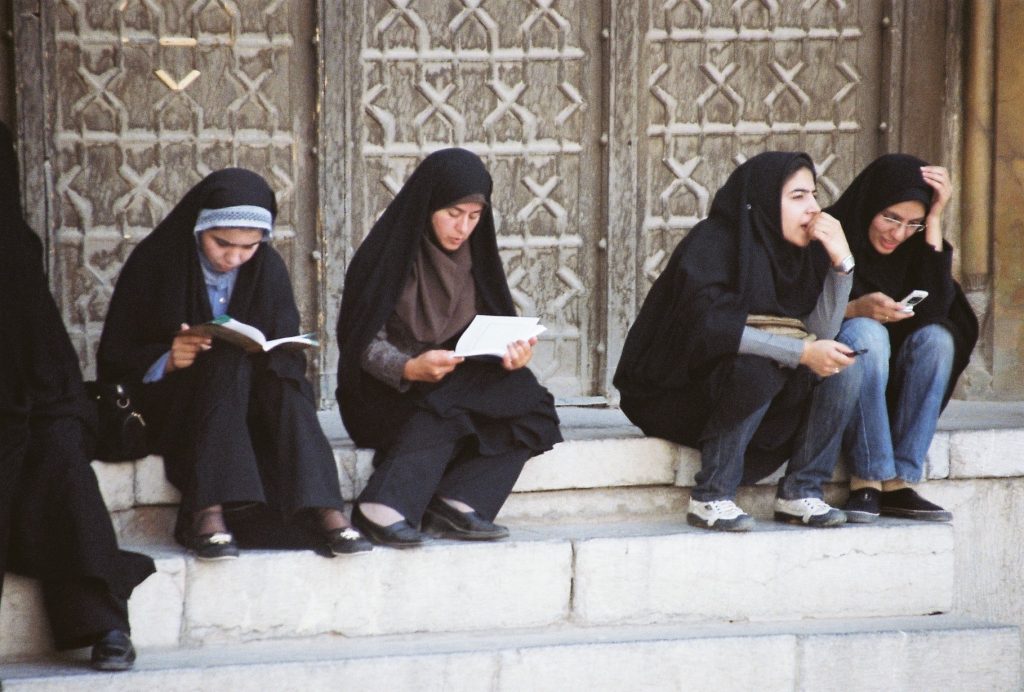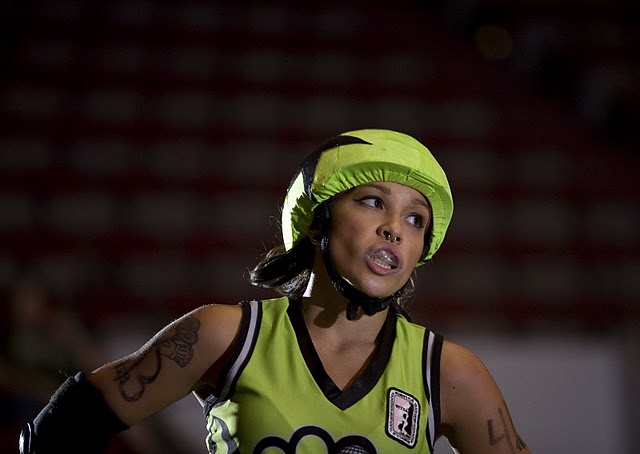This way for the gas
“Ladies and gentlemen, I want you to imagine prisoners lined up on these streets for morning and evening roll calls,” says our guide (blond, asymmetrical haircut, excellent English). I wonder if he’s a student or if this is it for him, death camps all day. “Sometimes it took hours, even in coldest weather, and Polish winters can be quite cold, ladies and gentlemen. But SS officers had to get their ledgers right.” I look over at my companion, but he is solemn and unavailable (headset over ears). “And now, ladies and gentlemen, follow me inside block 15 where we will see a complete map of camps and ghettos.” My head pulsates with a dull but persistent pain, and his words merge with my internal pleas—if only this headache would go away, ladies and gentlemen. Then what? Would I be able to enjoy the experience?
“Ladies and gentlemen with video cameras, you are not allowed to film human hair and teeth.” What about the cloth made from human hair? What about the artificial limbs and crutches? The enamel pots and pans? “You are allowed to take pictures of the shoes and the suitcases. Notice they give owners’ names and places of origin. This one says Waisenkind; that’s German for orphan.” I take out my phone and snap a photo of a red shoe among a sea of dark, faded leather. It’s a shiny sandal with a low heel—a party shoe. It reminds me of something I heard when I was little, that red shoes only belong on children and prostitutes. I didn’t own red shoes for a long time, but the previous summer my companion gifted me a pair of cranberry sandals when he saw them catch my eye in a shop. Would I want someone to see my sandals like this? I delete the photo.“Ladies and gentlemen, these are the cans of Zyklon B. They are empty now, of course.” Safe behind glass.
We pause in front of the Death Wall, also known as the Black Wall. Its charcoal stands out against the red brick behind it, a wall connecting two prison blocks. One wall to protect another wall, from bullet holes and bloodstains. “This is where planned executions took place.” And the unplanned? Today, there are flowers and little rocks tucked into the cracks between the stones. Unlike the Zyklon cans, this is a replica. “ The original was destroyed,” says our guide. While he speaks, I take off my headset and roll my neck to relieve tension. I don’t want to attend to my body, but my headaches have bad timing and no sense of place. The pulsing continues as we approach the chamber (grass knolls, small grated windows, red-brick chimney).
This way for the gas, ladies and gentlemen.
Memory impaired
Before Birkenau, we break and I wait for the bathrooms, instinctively taking out my phone. But there are no missed calls from home and no new photos to scroll through. I can’t escape the line, so I flip the złoty needed for payment between my fingers.
It’s been suggested that taking a picture of an object hinders one’s memory of it. We become less present, less observant of what’s around us. We recall less. Linda Henkel calls this the “photo-taking-impairment effect.” Can the process happen in reverse? I spent years thinking about the Holocaust. I carry with me images from countless photos, films, memoirs, novels, historical accounts. I know the historiographical debates and the representation debates and the memory debates. I taught a course called “Memory Spaces.” I screened Night and Fog for my students. In two other courses we read Maus I and II. When standing by the “Arbeit macht frei” gate, I remember Spiegelman’s drawing, the panel that dominates one of the last few pages of the first book, announcing his parents’ arrival in the place they already associated with gas, ovens, death. They came by train, we came by tour buses.
When you study the history, read the poems, look at images of monuments and counter-monuments, you always feel that a piece is missing, that your knowledge is incomplete without contact with the artifact. It’s people we care about, but to know them, we need to be where they lived and died.
Isn’t this how we get closer?
After visiting camp museums, scholar and survivor Ruth Klüger wrote that Holocaust tourism is impossible without “the belief that the ghosts can be met and kept in their place.” The place is supposed to serve as a portal into the past, to “evoke the physical reality of the camps as they were when they functioned.” Ironically, Klüger found that what was missing in the spaces was the intangible,“the odor of fear emanating from human bodies, the concentrated aggression, the reduced minds.” Survivors and visitors, even over-prepared ones like me, yearn for what Klüger called “timescapes” or “evocations of places at a time that has passed.” But this is a yearning that can never be fulfilled, certainly not by unassuming brick buildings with painted rooms (ashes, prayer shawls, oven doors). Klüger did not encounter the ghosts of the people she saw in the camps.
It’s hard to commune with the dead when you are attending to your body. But didn’t I see my companion cry back there, in front of the suitcases? Did he smell the odor from human bodies?
We stand outside the camp eating our lunch (bus in view). Like good tourists, we packed snacks of pretzels and cookies. Some of our fellow travelers are filling up on greasy pastries and caffeine in the café down by the bathrooms. Others smoke, pacing outside. I wonder how many of them plan to visit the salt mines after the camps. We thought about doing it too. Who doesn’t want to see an underground world carved out of salt (chapels, chandeliers, indoor lakes)? And the deal, combined with the camp tour, was a good one.
We pack up our food, and I see a cigarette butt lying on the grass. Someone attended to the body.
Old stories
Every birthday I hear the same story. Shortly after I was born, a doctor paid a house call to check on the new mother and baby, as was still the custom in Soviet Ukraine. At the time, my parents lived together with my grandparents and uncle, all of us in a three-room apartment in a communist bloc building (16th floor). My grandmother came to the door and the doctor, mistaking her for my mother, asked how she was recovering. She wore her Polish dressing gown. The detail stayed with me, lodging into my brain the association between Polish goods, quality, and youth. In late-80s Ukraine, Poland was almost the West. It was aspirational but also familiar and accessible to some. We had friends who traveled there under special visas. They always brought back foods and clothes unavailable in the USSR. The Poles have better goods, so they must be good, I thought. I had never heard anything to the contrary.
In the decade of my birth, Klüger also heard stories of Polish goodness, when talking with German students who were eager to parrot the notion that “the Poles had been invaded and mistreated, so they must be good.” The mistreatment of Poles is everywhere in Auschwitz. As a visitor, one cannot escape narratives that quantify and vivify Polish suffering, often at the expense of broaching complicity. Not dealing with complicity makes things neater. Two years after our visit, Poland would try to pass a law criminalizing discussion of the country’s collaborations with Nazis, punishable by up to three years in prison.
“How else are we to tell victims from victimizers?”
The Poles had been invaded and mistreated, so they must be good. The Hungarians had been invaded and mistreated, so they must be good. The Lithuanians had been invaded and mistreated, so they must be good. The Latvians had been invaded and mistreated, so they must be good. The Ukrainians had been invaded and mistreated, so they must be good. And the Russians must be good. So who screamed “Beat the kikes! Save Mother Russia!” And did Ukrainians welcome the Nazis with bread and salt, as I heard when I was a child? Maybe this was an exaggeration. It can be hard to tell victims and victimizers apart.
It can also be hard to tell who the victims are.
I know because I used to play next to a mass grave. This was in one of my childhood neighborhoods, the first and only where my mother and I lived on our own, after my parents’ divorce. A short walk from our building was a park and in that park a ravine. And in that ravine the remains of Jews, murdered in what was likely the deadliest mass killing by Nazis.
The last fact I only learned in graduate school. Growing up, there was only the confusion of socialist realist statues, the tangle of abstract bodies perched above the ravine—Red Army soldiers (boots, overcoat, beret), nondescript men (bulging muscles), women (naked breasted, clutching children). Jews were slaughtered here, but these figures looked like they had escaped propaganda posters.
My parents took their wedding photos in front of the monument (dusty rose dress, bell bottoms). Even as a child I thought this was a strange choice but couldn’t say why.
Purchase MQR 58:4 to read the rest of this essay from Maggie Levantovskaya and more fiction, nonfiction, and poetry from “What Does Europe Want Now?”




